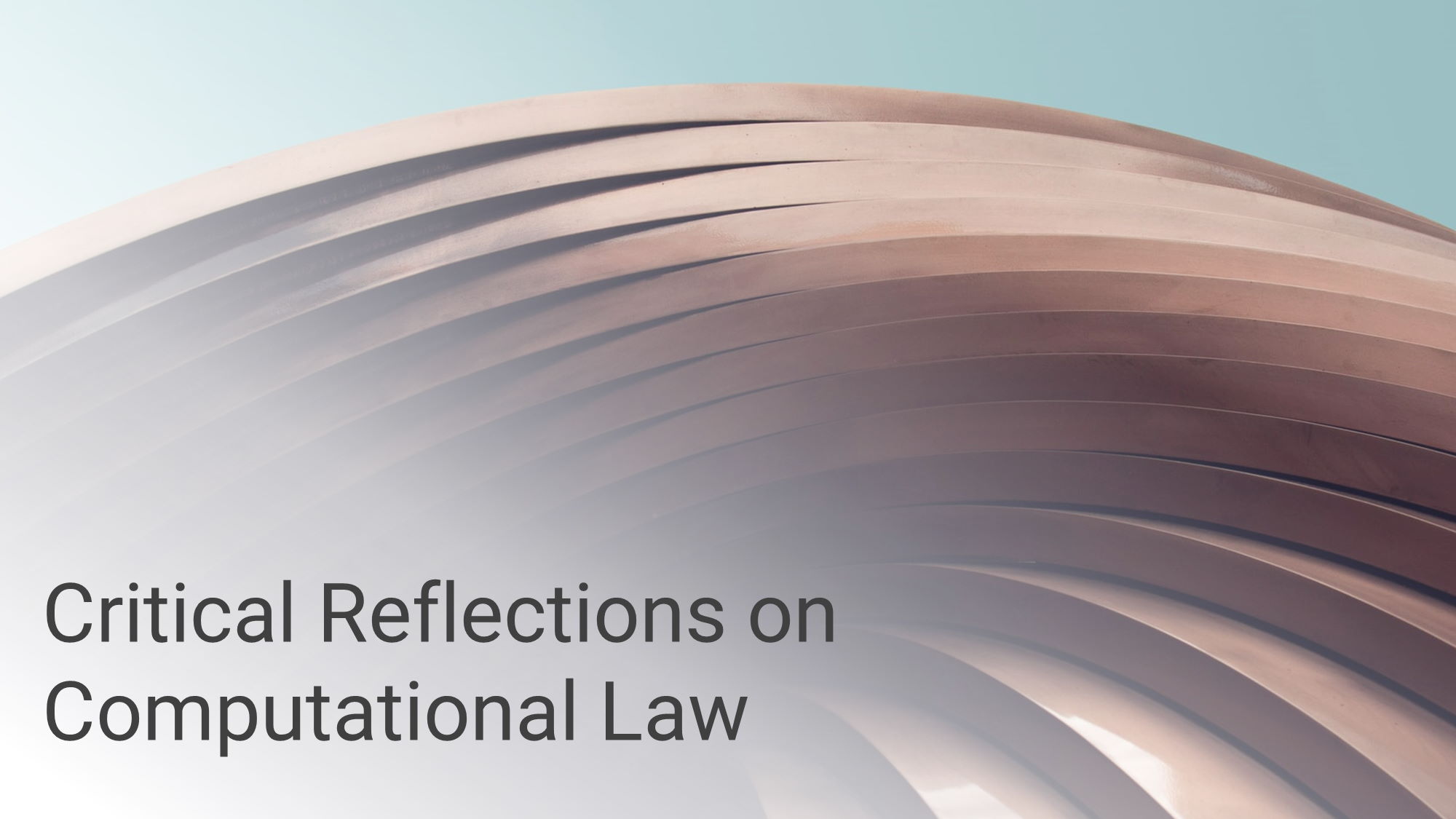
Master course:
Critical Reflections on Computational Law
This 11-lecture masters-level course was designed by Laurence Diver and Mireille Hildebrandt, and delivered at the Buchmann Faculty of Law, Tel Aviv University, in April-May 2022.
The course aims to help students understand the interplay between legal theory and the real-world impacts of technologies, both generally and specifically in the legal domain. The Typology of Legal Technologies plays a core role in the course assessment, challenging students to properly engage with the claims made by the systems’ providers and to consider whether or not those systems could have an impact on legal protection.
The syllabus below is made available under a Creative Commons BY-NC license.
Course description
This course engages with both practical and theoretical inquiry into the deployment of AI in legal practice (data-driven law) and the transcription of legal norms into computer code (code-driven law).
The objective is to sensitize law students to the assumptions and methodological constraints of computer science, to learn how to ask the right questions when assessing ‘legal tech’, and to develop acuity with regard to how computational law may affect human rights and the rule of law.
Learning outcomes:
- Understand the primary conceptions of law, with an emphasis on text-driven normativity
- Appreciate the role of technology in the development of modern law
- Understand of the main approaches to data- and code-driven computation
- Be sensitive to the frictions and (in)compatibilities between law and computation
- Have an up-to-date awareness of the legal tech landscape
- Understand the role of positive law in protecting fundamental rights
- Appreciate the challenges of conducting cross-disciplinary research
Course syllabus
Course assessment
This assessment commences after Class 3.
Each student will be assigned one of the legal techs discussed in Classes 2 and 7. The RQ should be connected to that specific legal tech, which must be studied in sufficient detail. One of the issues each student will address is whether – and if so to what extent – the deployment of the specific legal tech may have direct or indirect legal effect.
- 20% of grade depends on a research question (RQ) combined with a 500-word abstract and a tentative bibliography of around 15 references.
- 80% of the course grade depends on the final paper.
Research question
You will develop a RQ that clearly interacts with the content of the course. The question must be open (no questions to which you already know the answers), and the answer should be based on a clear methodology (that is part of your own disciplinary background). The abstract should clarify how the RQ relates to the content of the course and the references should include at least 5 references that are part of the core readings of the course.
The abstract will also indicate how the legal tech may generate legal effect when deployed.
Full paper
Each paper should consist of the following parts (word counts are indicative):
- Introduction of the RQ (200 words)
- Connection with the assigned LegalTech (500)
- Exploration of what consequences the LegalTech may have in terms of direct or indirect legal effect (1000)
- Argumentation of how this may affect the Rule of Law (500)
- Argumentation of what Legal Protection by Design could mean here (500)
- Conclusion (300)
Class 1: What do we mean by 'computational law'?
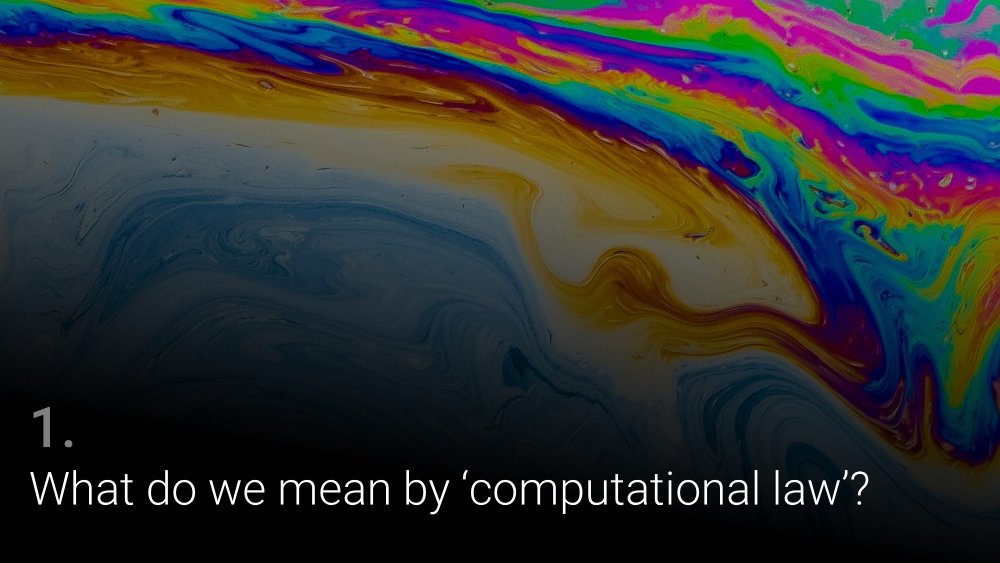
After this lecture students will (i) understand the broad questions that arise in computational law, (ii) understand the main concepts and vocabulary, (iii) appreciate the increasing role of legal tech in practice and education.
Required reading
- Mireille Hildebrandt, ‘A Philosophy of Technology for Computational Law’ in Mangan et al (eds.), The Philosophical Foundations of Information Technology Law (OUP 2020) (15pp)
Optional reading
- Laurence Diver, ‘A Legal Philosophy Perspective: Code is Less than Law’ in Laurence E Diver, Digisprudence: Code as Law Rebooted (Edinburgh University Press 2022) (39pp)
Class 2: Computational law in the real world I
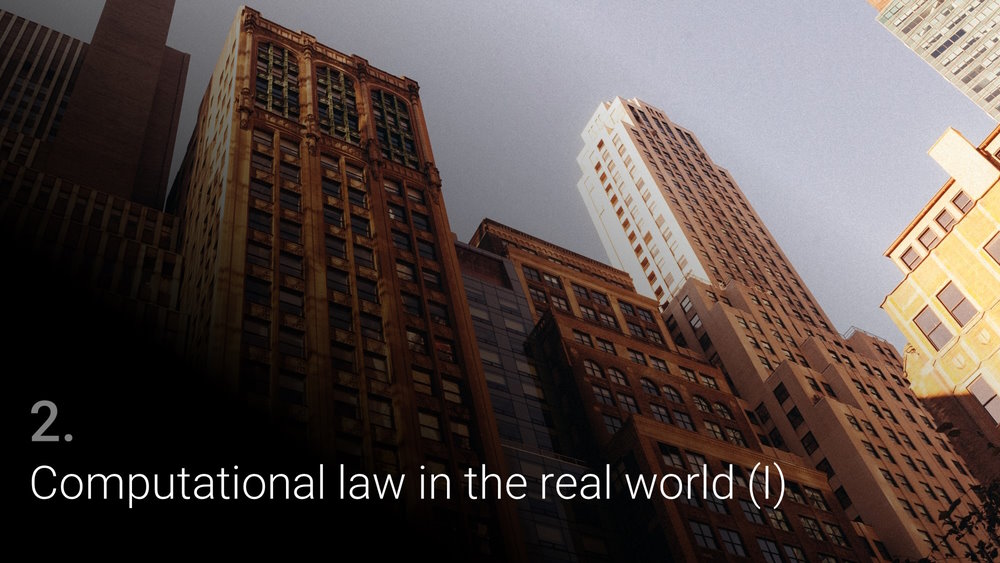
After this interactive session students will (i) understand the legal tech landscape, (ii) appreciate the difference between law and legal services, (iii) be able to differentiate commercial claims made by legal tech providers from their technical substantiation, (iv) have a sense of the challenges involved in developing and executing cross-disciplinary and multi-audience methodology, (v) appreciate the value of combining primary research, collaboration, and unorthodox communication methods.
For this session students prepare the following assignment:
- Access and play around with the Typology of Legal Technologies
- Use different filters
- Compare types in the same filter
- Focus on ‘Claims’ and ‘Substantiation’ in the profiles of legal technologies
- Study the required reading and ask yourself:
- What is the added value for legal practice?
Required reading
- ‘How do you define “Legal Tech”?’ (Artificial Lawyer, 2021) (5pp)
- COHUBICOL, ‘Typology of Legal Technologies’ (2022) inc. methodology and disclaimer (~10pp)
Class 3: What is 'data-driven' law?
After this lecture students will (i) understand the basics of machine learning, (ii) understand the commitments and trade-offs that ML necessarily entails, (iii) appreciate the issues involved in treating legal texts as data.
Required reading
-
Tom Mitchell, ‘Key Ideas in Machine Learning’ in Machine Learning (2nd ed., 2017) pp. 1–11 (10pp)
-
Masha Medvedeva et al., ‘Rethinking the Field of Automatic Prediction of Court Decisions’ [2022] Artificial Intelligence and Law (15pp)
Optional reading
-
Mireille Hildebrandt, ‘Boundary work between computational “law” and “law as-we-know-it”’, in D Curtin and M Catanzariti (eds.), Data at the Boundaries of European Law, Collected Courses of the Academy of European Law Vol. XXX (Oxford University Press, forthcoming) (32 pp)
-
Ilias Chalkidis et al., ‘LexGLUE: A Benchmark Dataset for Legal Language Understanding in English’ (2021) SSRN Scholarly Paper ID 3936759 (Rochester, NY: Social Science Research Network) (17 pp)
Class 4: What is 'code-driven' law?
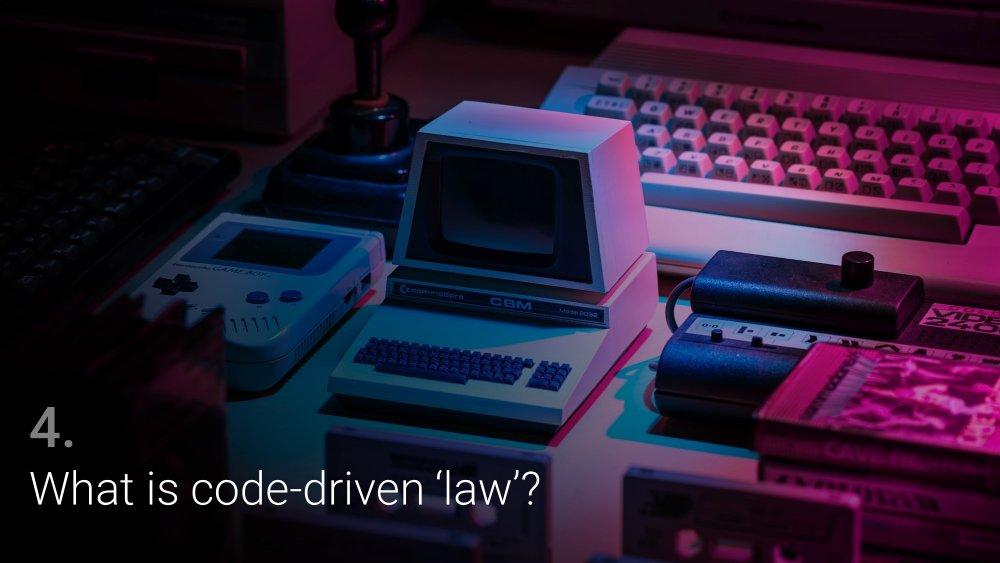
After this lecture students will (i) understand different uses of code-driven law by public and private entities, (ii) appreciate the connection between the philosophy of technology and code-driven law, (iii) understand the interpretative affordances of source code and their relation to law.
Required reading
-
Matthew Waddington, ‘Rules as Code’ (2020) 37 Law in Context. A Socio-legal Journal 179 (8pp)
-
‘Comments on OECD’s Cracking the Code: Rulemaking for Humans and Machines (August 2020 Draft)’ (version 2, 2021), ch. 1 (Barnes), ch. 3 (Casanovas), ch. 4 (Zeleznikow), ch. 5 (Governatori) (19pp)
Optional reading
- Denis Merigoux, ‘The Specification Problem of Legal Expert Systems’ (2022) (10pp)
Class 5: What do we mean by the Rule of Law?
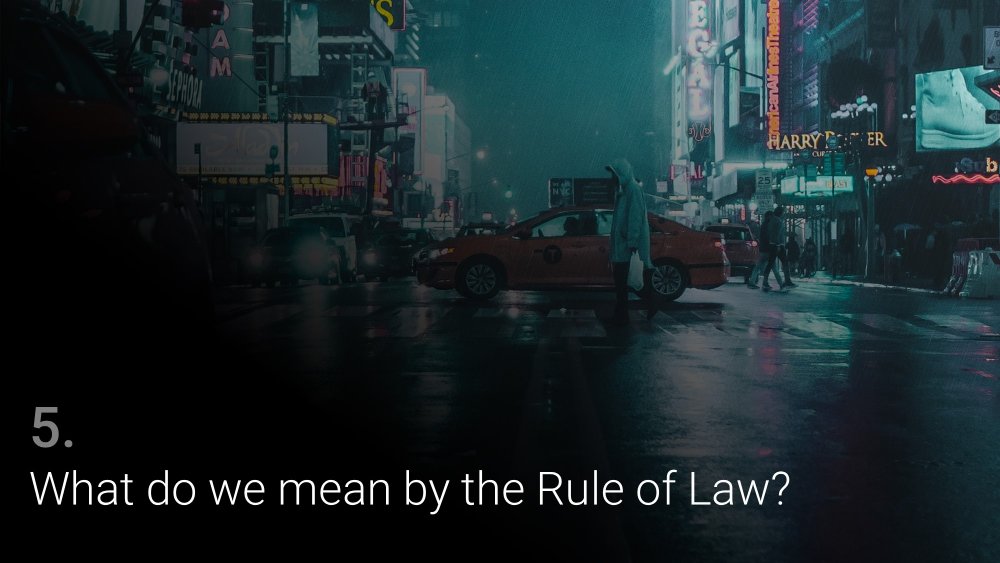
After this lecture students will (i) understand the primary conceptions of law, (ii) be able to situate modern law within an historical and technological context, (ii) understand the connection between the Rule of Law and democratic and political theory.
Required reading
-
Mireille Hildebrandt, ‘Intricate Entanglements of Law and Technology’ in M Hildebrandt, Smart Technologies and the End(s) of Law (Elgar 2015) pp. 159-185 (26pp)
-
Gustav Radbruch, ‘Five Minutes of Legal Philosophy (1945)’ (2006) 26 Oxford Journal of Legal Studies 13 (3pp)
Optional reading
-
Jack Goody and Ian Watt, ‘The Consequences of Literacy’ (1963) 5 Comparative Studies in Society and History 304 (41pp)
-
Walter J Ong, Orality and Literacy: The Technologizing of the Word (3rd edn., London: Routledge, 2012)
Class 6: What do we mean by computation?
After this lecture students will (i) understand the central themes in computational thinking and design, (ii) understand the difference between induction and deduction, with a view toward legal application.
Required reading
-
John Searle, ‘Minds, Brains, and Programs’ (1980) 3 Behavioral and Brain Sciences 417 (8pp)
-
Brian Cantwell Smith, ‘History’ in The Promise of Artificial Intelligence: Reckoning and Judgment (Cambridge, MA: The MIT Press, 2019) pp. 7-21 (14pp)
-
Rodney Brooks, ‘How Claude Shannon Helped Kick-start Machine Learning’ (IEEE 2022) (3pp)
Optional reading
-
Mireille Hildebrandt, ‘Law as Computation in the Era of Artificial Legal Intelligence: Speaking Law to the Power of Statistics’ (2018) 68 University of Toronto Law Journal 12 (24pp)
-
Mireille Hildebrandt, ‘Law as Information in the Era of Data‐Driven Agency’ (2016) 79(1) The Modern Law Review 1 (30pp)
Class 7: Computational law in the real world II
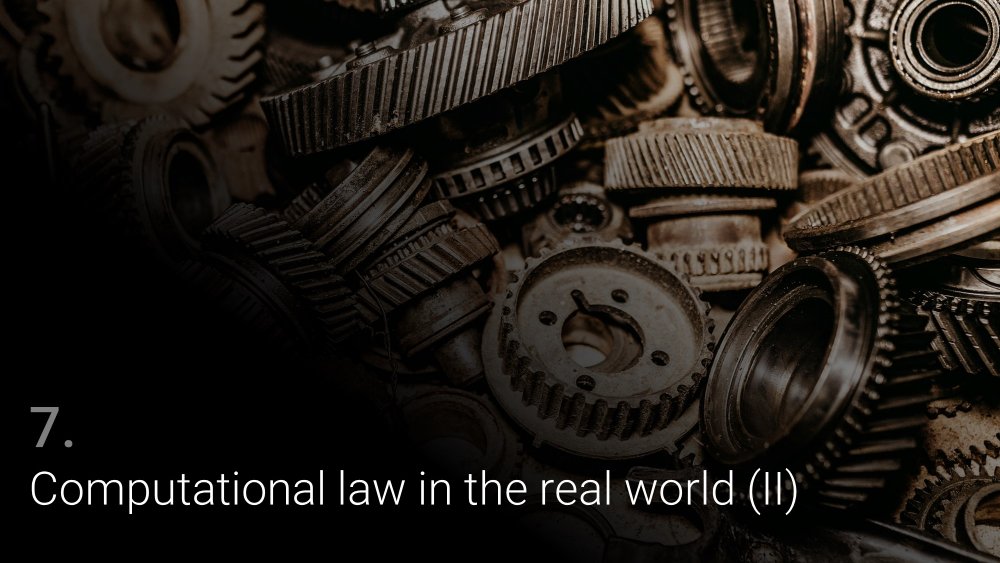
After this interactive session, students will (i) be able to identify different types of so-called ‘legal techs’, (ii) be capable of comparing what providers or developers claim in terms of the functionality of these systems, (iii) be able to assess the extent to which the substantiation of such claims can be reliably assessed, (iv) appreciate how the interface of a legal tech system mediates the lawyer’s understanding of the law, (v) detect whether and how they may generate direct or indirect legal effect, for instance in terms of art. 22 of the General Data Protection Regulation (GDPR).
For this session students prepare the following assignment:
- Access and play around with the Typology of Legal Technologies:
- Use different filters
- Compare different types of legal tech in the same filter
- Focus on ‘How might the end-user assess effectiveness?’ in the legal technology profiles
- Study the core reading and ask yourself:
- Do these legal techs have direct or indirect legal effect?
Required reading
-
Reuben Binns and Michael Veale, ‘Is that your final decision? Multi-stage profiling, selective effects, and Article 22 of the GDPR’ (2021) 11(4) International Data Privacy Law 319 (14pp)
-
Schufa Holding Case C-634/21 (Request for preliminary hearing) (18pp)
Optional reading
- Laurence Diver and Pauline McBride, ‘Argument by Numbers: The normative impact of statistical legal tech’ (2022) Communitas
Class 8: Our interactions with machines

After this lecture students will (i) understand the relationality of artefacts, (ii) appreciate critical perspectives on technology and design, (iii) appreciate the connection between modern law and the technologies it relies upon.
Required reading
- Laurence Diver, ‘A Design Perspective: Code is More than Law’ in Laurence E Diver, Digisprudence: Code as Law Rebooted (Edinburgh University Press, 2022), pp. 43-67 (24pp)
Optional reading
- Madeleine Akrich, ‘The De-Scription of Technical Objects’ in WE Bijker and J Law (eds.), Shaping Technology/Building Society: Studies in Sociotechnical Change (MIT Press, 1992) (20pp)
- Bruno Latour, ‘The Berlin Key or How To Do Words with Things’ in P Graves-Brown (ed.), Matter, Materiality and Modern Culture (London: Routledge, 2000) (11pp)
- Langdon Winner, ‘Do Artifacts Have Politics?’ [1980] Daedalus 121 (16pp)
- Manuel Heras-Escribano, The Philosophy of Affordances (Springer: Cham, 2019)
Class 9: How do computation and the Rule of Law differ?
After this lecture students will (i) have a deeper understanding of the normative conception of law, especially compared with the regulation paradigm, (ii) appreciate how broader philosophical perspectives inform the ethos of law.
Required reading
- Laurence Diver, ‘1.4 “Code as Law”, Code versus Law, or Something Else?’ (pp. 22-32) and ‘A Legal Philosophy Perspective: Code is Less than Law’ (pp. 79-105) in Laurence E Diver, Digisprudence: Code as Law Rebooted(Edinburgh University Press, 2022) (36pp)
Optional reading
- Mireille Hildebrandt, ‘Law as Computation in the Era of Artificial Legal Intelligence: Speaking Law to the Power of Statistics’ (2018) 68 University of Toronto Law Journal 12 (24pp)
- Karen Yeung and Martin Lodge, ‘Algorithmic Regulation: An Introduction’ in Algorithmic Regulation (OUP, 2019) pp.1-13 (13pp)
- Andrew Selbst et al., ‘Fairness and Abstraction in Sociotechnical Systems’, Proceedings of the Conference on Fairness, Accountability, and Transparency (FAT) (Atlanta GA USA: ACM, 2019) (10pp)
Class 10: The proposed EU AI Act demonstrating Legal Protection by Design (LPbD) as an affordance of positive law
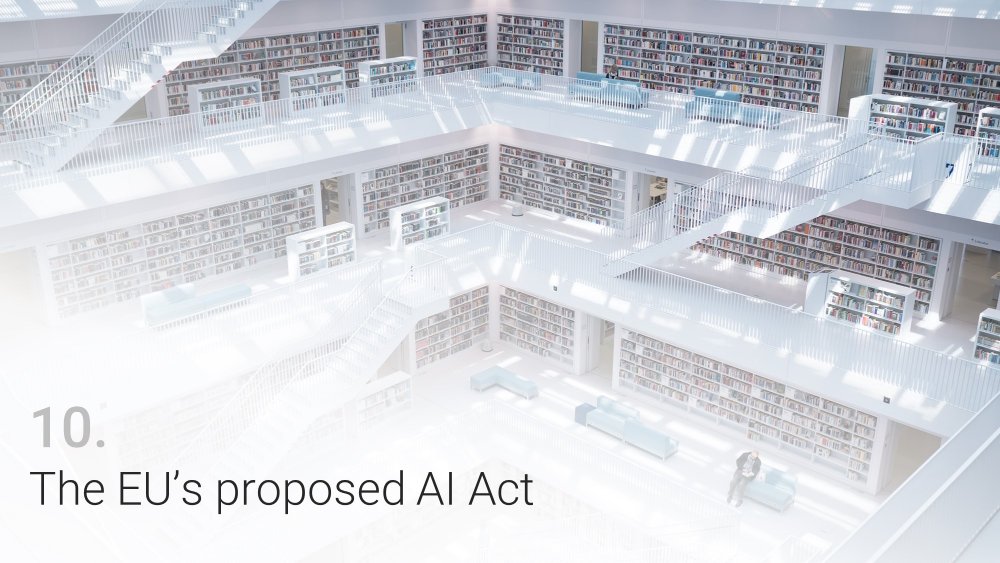
After this lecture students will (i) have a proper understanding of the structure of the proposed AI Act, (ii) be able to identify provisions that require ‘legal protection by design’, (iii) understand how existing positive law fosters LPbD.
Required reading
- European Commission proposed Artificial Intelligence Act: Explanatory Memorandum (16pp); Detailed explanation of the provisions of the proposal (4pp); Art. 3 and Titles II and III (29pp); Annex I (1p)
- Michael Veale and Frederik Borgesius, ‘Demystifying the Draft EU Artificial Intelligence Act’ (2021) 4 Computer Law Review International 97 (16pp)
Optional reading
- Mireille Hildebrandt, ‘Global Competition and Convergence of AI Law’ in Smits et al. (eds.), Elgar Encyclopedia for Comparative Law (Elgar, forthcoming) (15pp)
- Roger Brownsword, ‘Technological Management and the Rule of Law’ (2016) 8 Law, Innovation and Technology 100 (41pp)
Class 11: Reflecting LPbD in technology production

After this lecture students will (i) understand the relationship between Rule of Law legitimacy and the affordances of technologies, (ii) appreciate how production practice affects the ultimate affordances of products, (iii) have a sense of how targeting providers and developers ex ante is necessary for LPbD, (iv) gain a broad understanding of software development approaches and their relationship to LPbD and (v) understand the difference between LPbD and ‘legal by design’.
Required reading
- ‘Operationalising Digisprudence’ in Laurence E Diver, Digisprudence: Code as Law Rebooted(Edinburgh University Press 2022) pp. 207-229 (22pp)
- Mireille Hildebrandt, ‘Saved by Design? The Case of Legal Protection by Design’ (2017) NanoEthics 1–5 (4pp)
Optional reading
- Mireille Hildebrandt, ‘“Legal by Design” or “Legal Protection by “Design”?’ in M Hildebrandt, Law for Computer Scientists and Other Folk (OUP 2020) pp. 251-277 (26pp)
- Paul Lippe, Daniel Martin Katz, and Dan Jackson, ‘Legal by Design: A New Paradigm for Handling Complexity in Banking Regulation and Elsewhere in Law’ (2015) 93(4) Oregon Law Review 833–52 (20 pp)
- Laurence Diver, ‘Interpreting the Rule(s) of Code: Performance, Performativity, and Production’ (2021) MIT Computational Law Report (41pp)
Full reading list
Shown in order of appearance in the course.
Required reading
Articles and chapters
- Mireille Hildebrandt, ‘A Philosophy of Technology for Computational Law’ in Mangan et al (eds.), The Philosophical Foundations of Information Technology Law (OUP 2020) (15pp)
- Tom Mitchell, ‘Key Ideas in Machine Learning’ in Machine Learning (2nd ed., 2017) pp. 1–11 (10pp)
- Masha Medvedeva et al., ‘Rethinking the Field of Automatic Prediction of Court Decisions’ [2022] Artificial Intelligence and Law (15pp)
- Matthew Waddington, ‘Rules as Code’ (2020) 37 Law in Context. A Socio-legal Journal 179 (8pp)
- ‘Comments on OECD’s Cracking the Code: Rulemaking for Humans and Machines (August 2020 Draft)’ (version 2, 2021), ch. 1 (Barnes), ch. 3 (Casanovas), ch. 4 (Zeleznikow), ch. 5 (Governatori) (19pp)
- Mireille Hildebrandt, ‘Intricate Entanglements of Law and Technology’ in M Hildebrandt, Smart Technologies and the End(s) of Law (Elgar 2015) pp. 159-185 (26pp)
- Gustav Radbruch, ‘Five Minutes of Legal Philosophy (1945)’ (2006) 26 Oxford Journal of Legal Studies 13 (3pp)
- John Searle, ‘Minds, Brains, and Programs’ (1980) 3 Behavioral and Brain Sciences 417 (8pp)
- Brian Cantwell Smith, ‘History’ in The Promise of Artificial Intelligence: Reckoning and Judgment (Cambridge, MA: The MIT Press, 2019) pp. 7-21 (14pp)
- Rodney Brooks, ‘How Claude Shannon Helped Kick-start Machine Learning’ (IEEE 2022) (3pp)
- Reuben Binns and Michael Veale, ‘Is that your final decision? Multi-stage profiling, selective effects, and Article 22 of the GDPR’ (2021) 11(4) International Data Privacy Law 319 (14pp)
- Laurence Diver, ‘A Design Perspective: Code is More than Law’ in Laurence E Diver, Digisprudence: Code as Law Rebooted (Edinburgh University Press, 2022), pp. 43-67 (24pp)
- Laurence Diver, ‘1.4 “Code as Law”, Code versus Law, or Something Else?’ (pp. 22-32) and ‘A Legal Philosophy Perspective: Code is Less than Law’ (pp. 79-105) in Laurence E Diver, Digisprudence: Code as Law Rebooted(Edinburgh University Press, 2022) (36pp)
- Michael Veale and Frederik Borgesius, ‘Demystifying the Draft EU Artificial Intelligence Act’ (2021) 4 Computer Law Review International 97 (16pp)
- Laurence Diver, ‘Operationalising Digisprudence’ in Laurence E Diver, Digisprudence: Code as Law Rebooted(Edinburgh University Press 2022) pp. 207-229 (22pp)
- Mireille Hildebrandt, ‘Saved by Design? The Case of Legal Protection by Design’ (2017) NanoEthics 1–5 (4pp)
Positive law
- European Commission proposed Artificial Intelligence Act: Explanatory Memorandum (16pp); Detailed explanation of the provisions of the proposal (4pp); Art. 3 and Titles II and III (29pp); Annex I (1p)
- Schufa Holding Case C-634/21 (Request for preliminary hearing) (18pp)
Grey literature
- ‘How do you define “Legal Tech”?’ (Artificial Lawyer, 2021) (5pp)
- COHUBICOL, ‘Typology of Legal Tech’ (2022) inc. methodology and disclaimer (~10pp)
Optional reading
Articles and chapters
-
Laurence Diver, ‘A Legal Philosophy Perspective: Code is Less than Law’ in Laurence E Diver, Digisprudence: Code as Law Rebooted (Edinburgh University Press 2022) (39pp)
-
Mireille Hildebrandt, ‘Boundary work between computational “law” and “law as-we-know-it”’, in D Curtin and M Catanzariti (eds.), Data at the Boundaries of European Law, Collected Courses of the Academy of European Law Vol. XXX (Oxford University Press, forthcoming) (32 pp)
-
Ilias Chalkidis et al., ‘LexGLUE: A Benchmark Dataset for Legal Language Understanding in English’ (2021) SSRN Scholarly Paper ID 3936759 (Rochester, NY: Social Science Research Network) (17 pp)
-
Denis Merigoux, ‘The Specification Problem of Legal Expert Systems’ (2022) (10pp)
-
Jack Goody and Ian Watt, ‘The Consequences of Literacy’ (1963) 5 Comparative Studies in Society and History 304 (41pp)
-
Walter J Ong, Orality and Literacy: The Technologizing of the Word (3rd edn., London: Routledge, 2012)
-
Mireille Hildebrandt, ‘Law as Computation in the Era of Artificial Legal Intelligence: Speaking Law to the Power of Statistics’ (2018) 68 University of Toronto Law Journal 12 (24pp)
-
Mireille Hildebrandt, ‘Law as Information in the Era of Data‐Driven Agency’ (2016) 79(1) The Modern Law Review 1 (30pp)
-
Laurence Diver and Pauline McBride, ‘Argument by Numbers: The normative impact of statistical legal tech’ (2022) Communitas (13pp)
-
Madeleine Akrich, ‘The De-Scription of Technical Objects’ in WE Bijker and J Law (eds.), Shaping Technology/Building Society: Studies in Sociotechnical Change (MIT Press, 1992) (20pp)
-
Bruno Latour, ‘The Berlin Key or How To Do Words with Things’ in P Graves-Brown (ed.), Matter, Materiality and Modern Culture (London: Routledge, 2000) (11pp)
-
Langdon Winner, ‘Do Artifacts Have Politics?’ [1980] Daedalus 121 (16pp)
-
Manuel Heras-Escribano, The Philosophy of Affordances (Springer: Cham, 2019)
-
Karen Yeung and Martin Lodge, ‘Algorithmic Regulation: An Introduction’ in Algorithmic Regulation (OUP, 2019) pp.1-13 (13pp)
-
Andrew Selbst et al., ‘Fairness and Abstraction in Sociotechnical Systems’, Proceedings of the Conference on Fairness, Accountability, and Transparency (FAT) (Atlanta GA USA: ACM, 2019) (10pp)
-
Mireille Hildebrandt, ‘Global Competition and Convergence of AI Law’ in Smits et al. (eds.), Elgar Encyclopedia for Comparative Law (Elgar, forthcoming) (15pp)
-
Roger Brownsword, ‘Technological Management and the Rule of Law’ (2016) 8 Law, Innovation and Technology 100 (41pp)
-
Mireille Hildebrandt, ‘“Legal by Design” or “Legal Protection by “Design”?’ in M Hildebrandt, Law for Computer Scientists and Other Folk (OUP 2020) pp. 251-277 (26pp)
-
Paul Lippe, Daniel Martin Katz, and Dan Jackson, ‘Legal by Design: A New Paradigm for Handling Complexity in Banking Regulation and Elsewhere in Law’ (2015) 93(4) Oregon Law Review 833–52 (20 pp)
-
Laurence Diver, ‘Interpreting the Rule(s) of Code: Performance, Performativity, and Production’ (2021) MIT Computational Law Report (41pp)